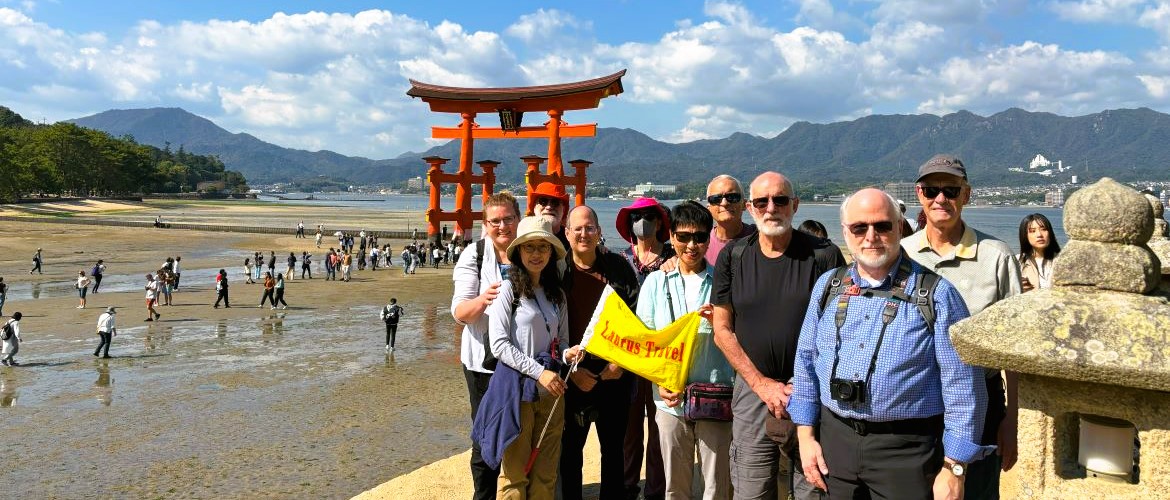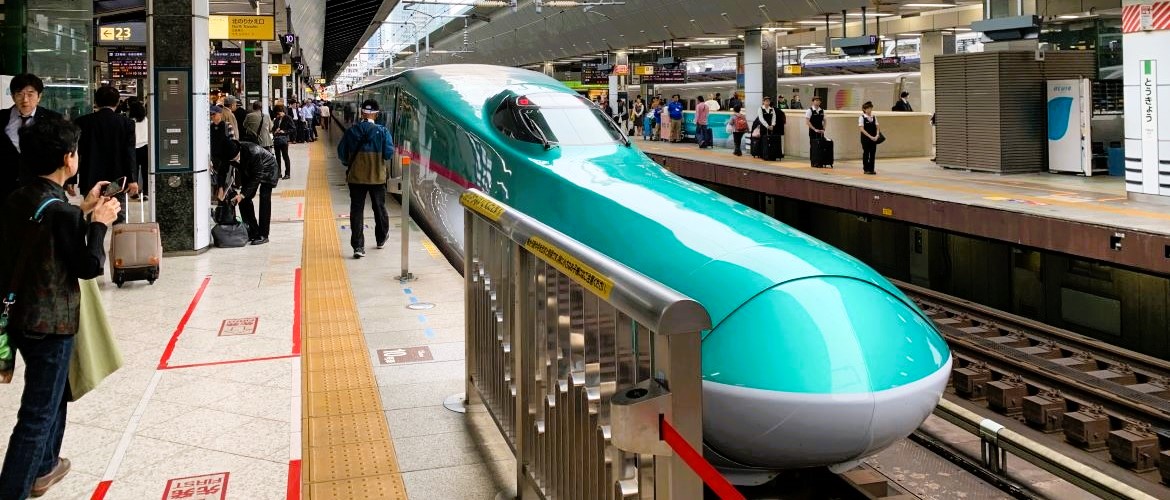Kyoto – Nara – Osaka – Hiroshima – Miyajima – Nagasaki – Naha – Tokyo
Explore Japan’s vibrant culture, marvel at its stunning natural beauty, savor exquisite Japanese cuisine, witness the grace of a maiko performance, and uncover the wonders of UNESCO World Heritage sites.
Join us on this inspiring small-group journey of discovery and elevate your sense of cultural travel to a higher level.
Important Features
- Small group size (average 15, maximum 20)
- Expert professional guides
- No annoying shopping stops
- Immersive cultural activities
- Quality Japanese and Western cuisines
- Special dinners featuring maiko performance & premium wagyu beef
Meal Code: B = breakfast / L = lunch / D = dinner
Day 1/Sat: Departing for Japan
The journey begins with your transpacific flight departing from a city of your choice. You’ll lose a day upon crossing the International Date Line.
Day 2/Sun: Arrival in Kyoto
Welcome to Kyoto!
Please make your way to the hotel on your own. Detailed up-to-date information on how to get to the hotel will be provided in the pre-trip update two weeks before departure.
Day 3/Mon: Kyoto (B/L)
Nicknamed “City of Ten Thousand Shrines”, Kyoto (literal translation: capital city) served as Japan’s capital for more than one thousand years before the imperial court moved to Tokyo in 1868 with the onset of the Meiji Restoration (1868 to 1912, a historical period associated with the emergence of Japan as a modernized nation). Kyoto is a scaled replica of the Chinese Tang Dynasty’s capital Chang’an, present-day Xi’an. The Tang Dynasty (618 – 907) was a golden era in Chinese history and a time when Japanese adoption of Chinese culture reached its peak. Kyoto today, with a population of 1.5 million, forms a major part of the Kyoto-Osaka-Kobe metropolitan area.
Free morning to recover from jet lag or explore on your own.
Our first stop after lunch is Kinkaku-ji (Temple of Golden Pavilion). This is a Zen Buddhist temple and one of 17 locations comprising the Historic Monuments of Ancient Kyoto World Heritage Site.
We then proceed to the Arashiyama (Storm Mountain) area where our sightseeing takes in Tenryu-ji Temple and the Bamboo Forest. Located on the western outskirts of Kyoto, Arashiyama is famous for its immense natural beauty as well as its historical and cultural prominence due to the large number of well-preserved ancient Buddhist temples.
Day 4/Tue: Kyoto (B/D)
Today’s walking tour begins at the magnificent Nijo Castle. Construction of the castle began in 1601 under the order of Tokugawa Ieyasu, founder of the Tokugawa shogunate, but was not completed until 1626 during the reign of Iemitsu, the third Tokugawa shogun and grandson of Ieyasu. The Tokugawa shogunate was headquartered in Edo, present-day Tokyo, and Nijo Castle was the shogun’s residence in Kyoto where the imperial court was located. Nijo Castle is also the site that witnessed the ending of the Tokugawa shogunate. In late 1867, the last shogun, Yoshinobu, announced in the castle his decision to return his power back to the emperor. This was a watershed moment that helped usher in the Meiji Restoration, which, in turn, led to Japan’s industrialization and fundamentally transformed the Japanese society.
We then proceed to Kyoto Imperial Palace. Rich in tradition, Kyoto Imperial Palace preserves the look and ambiance of the palace as it had been in the time of Japan’s ancient imperial dynasties. The current Palace was rebuilt in 1855 and comprises several buildings that reflect the architectural styles of various periods. If Kyoto Imperial Palace is closed due to court functions, bad weather or any other reason, Higashi Hongan-ji, a Buddhist temple established by shogun Tokugawa Ieyasu in 1602, will be used as substitute.
Afterwards, we return to the hotel to freshen up before heading out for dinner, a traditional kaiseki banquet accompanied by the private performance of a dancing geisha known as maiko in Japanese.
Day 5/Wed: Kyoto (B)
Today is set aside for you to explore on your own.
Our recommendations include Kiyomizu-dera (Buddhist temple), Fushimi Inari Shrine (good for hiking), Ginkaku-ji (Silver Pavilion Temple), Kyoto National Museum, and Gion – the famous geisha entertainment district.
Day 6/Thu: Kyoto – Nara – Osaka – Hiroshima (B/L)
We depart for Nara at 07:45. The 45 km drive to the magnificent Todai-ji temple takes about an hour. This ancient Buddhist temple is well-known not only for its splendid architecture and the huge bronze statue of the Buddha in the main hall but also for the 1,200 wild deer roaming freely on the grounds of the temple.
Nara is the capital city of Nara Prefecture and a former capital of Japan (710 – 794). With a population of roughly 370,000 and an area of 280 square kilometres, the city occupies the northern part of Nara Prefecture. Eight temples, shrines and ruins together with Kasugayama Primeval Forest collectively form “The Historic Monuments of Ancient Nara” – a UNESCO World Heritage Site.
Afterwards we continue on to Osaka, where we visit the historic Osaka Castle and Osaka’s legendary shopping and entertainment district known as Dotonbori. Situated at the mouth of the Yodo River on Osaka Bay, Osaka is Japan’s third most populous city (after Tokyo and Yokohama) and plays a significant role in Japanese economy. Osaka was once known as the “nation’s kitchen” because of its function as Japan’s rice trading centre during the Edo period.
We then transfer to the Shin Osaka Station for the late afternoon rail journey to Hiroshima (Sakura 563, 16:23/17:51).
Day 7/Fri: Hiroshima – Miyajima – Hiroshima (B/D)
Hiroshima, literally meaning ‘broad island’, is the capital of Hiroshima Prefecture and the largest city in the Chugoku region with a population of 1.2 million. Hiroshima is best known as the first city in history to be targeted by a nuclear weapon when the United States Army Air Forces dropped an atomic bomb on the city (and later on Nagasaki) at 8:15 a.m. on August 6, 1945, near the end of World War II. The highlight in Hiroshima, understandably but sadly, is the Peace Memorial Park which includes the Peace Memorial Museum, and the Atomic Bomb Dome that once served as the industrial promotion hall of the local prefect.
After a tour of the Peace Memorial Park complex including two hours in the museum onsite, we proceed to Miyajima Island by a combination of taxi, commuter train and ferry.
Officially known as Itsukushima, Miyajima is a small island (30 square kilometres, population 1,760) in Hiroshima Bay known for its forests and ancient temples. The seaside Itsukushima Shinto Shrine on the island is a UNESCO World Heritage Site and the “floating” torii gate in front of the shrine is the main reason for most visitors to come here.
Day 8/Sat: Hiroshima – Nagasaki (B/D)
The rail journey to Nagasaki this morning takes 2 hours 42 minutes (09:47/12:29).
Located on the northwest coast of the island of Kyushu, Nagasaki is the capital of and the largest city in Nagasaki Prefecture with a population of 424,066 as of 2017. During the Tokugawa bakufu era (1603-1868) Nagasaki was the largest of the four Japanese ports allowed for international trade. The exposure to European influence, primarily Portuguese and Dutch, in those days certainly has left its mark on the city as evidenced by Nagasaki’s large number of Japanese Catholics and numerous European-style buildings throughout the city. Nagasaki also had the misfortune of being hit by an atomic bomb near the end of World War II, making it the second and last target of nuclear bombing in history.
Afternoon sightseeing begins at Dejima, the site of the Dutch trading post known as factory. Built on reclaimed land originally intended for the Portuguese, the 2-acre island was later offered to the Dutch, who used it from 1641 to 1854.
We then proceed to the Basilica of the Twenty-Six Holy Martyrs of Japan (also known as Oura Church), and adjacent Glover Garden built in 1863 for Thomas Blake Glover, a Scottish merchant who moved to Nagasaki as a young man, started a family with a Japanese woman and passed away in Tokyo at the age of 73.
Day 9/Sun: Nagasaki (B)
Morning sightseeing includes Nagasaki Peace Park and Chinatown.
Established in 1955 near the hypocenter of the atomic bombing on August 9, 1945, the Peace Park sits next to the Atomic Bombing Museum and the Peace Memorial Hall.
Nagasaki Shinchi Chinatown is the oldest Chinatown in Japan. The area in downtown Nagasaki was originally the location of the warehouses of Chinese traders. The Chinese merchants came to Nagasaki because it was the only open port in Japan during the Tokugawa period. Today, Nagasaki Shinchi Chinatown is a thriving district filled with a variety of shops and restaurants where visitors can find the best Champon and Sara Udon, two Chinese-influenced noodle dishes.
The afternoon is set aside for you to explore on your own. We recommend a walking tour of Teramachi (temple street), where 14 Buddhist temples and 2 Shinto shrines stand side by side. Two temples, Kofukuji and Sofukuji, are particularly famous. In the 16th and early 17th centuries, Nagasaki was a hub of international trade, with European and Chinese traders frequenting its ports. Chinese traders, who made up the majority of foreigners living in Nagasaki in those days, were avid temple builders whose enthusiasm was cheered on by the ruling shogunate in its effort in reigning in the spread of Christianity in western Japan.
Day 10/Mon: Nagasaki – Fukuoka – Naha (B/D)
This morning we travel to Fukuoka by train (2 hours 11 minutes) for mid-day or late afternoon flight (1 hour 45 minutes) to Naha. Transfer to the hotel on arrival and have the rest of the day at leisure.
Day 11/Tue: Naha (B/L)
In 1609, at the beginning of the Tokugawa shogunate, the independent Ryukyu Kingdom was invaded by the Japanese domain of Satsuma and was forced to cede the Amami Islands and become a vassal of Satsuma. In 1879, the Empire of Japan annexed the entire Ryukyu archipelago and turned it into Okinawa Prefecture. The monarchy in the capital of Shuri, now part of Naha, was abolished and the deposed king Shō Tai (1843–1901) was made to relocate to Tokyo.
During the Battle of Okinawa near the end of the Pacific War, civilians on the island of Okinawa suffered tremendous casualties due to participation in war efforts forced onto them by the Japanese military. Okinawa was the bloodiest battle of the Pacific War. It was reported that the US government was so shocked by the high number of casualties sustained by the US troops (12,520 killed in action, up to 55,162 wounded) during the campaign that it decided to utilize the newly developed nuclear bombs to hasten Japan’s surrender.
Morning sightseeing takes in Shurijo Castle and Tamaudun Mausoleum.
After lunch, we drive 20 kilometres through picturesque countryside to Okinawa Peace Memorial Park. Located in the city of Itoman and direct to the south of Naha, the park was established in 1975 next to the “Suicide Cliffs” where the Battle of Okinawa ended on June 21, 1945. A key highlight of the park is the Peace Memorial Museum.
Day 12/Wed: Naha (B)
Today is put aside for you to explore the tropical island of Okinawa on your own. Inside the city of Naha, Shikina-en Garden and Okinawa Prefectural Museum & Art Museum are recommended. The local seafood restaurant scene is also worth checking out.
Day 13/Thu: Naha – Tokyo (B/L)
We travel back to Tokyo by air (2 hours 45 minutes) in the morning and transfer to the hotel on arrival. After a delicious farewell luncheon, we spend the rest of the day exploring on our own.
Day 14/Fri: Tokyo (B/L)
Tokyo, literally meaning “eastern capital” and officially named Tokyo Metropolis, is one of the most populous mega-cities in the world with a population of 14 million. Formerly known as Edo, the city has been the de facto seat of the Japanese government since 1603 when shogun Tokugawa Ieyasu chose the city for his headquarters. The shogun (general) was a hereditary commander ceremoniously appointed by the emperor but held real power over the country during the shogunate period between 1192 and 1867. Edo was renamed Tokyo after Emperor Meiji moved his seat from Kyoto in 1868 when the last shogun was forced to return power to the imperial court. The city covers an area of 2,187 square kilometres following the merger in 1943 of the city of Tokyo and Tokyo Prefecture.
Our full-day sightseeing begins at the plaza in front of the Imperial Palace. The palace is closed to tourists but a stroll across the plaza accompanied by commentaries on the imperial family and the city of Tokyo gets the tour off to a good start.
We then proceed to Senso-ji, the oldest Buddhist temple in Tokyo dating back to 628.
After lunch, we drive through ritzy Ginza shopping district on the way to Meiji Jingu, a Shinto shrine dedicated to Emperor Meiji (1852 -1912) and his wife.
We end the day with a visit to the observation deck atop the Tokyo Metropolitan Government Building in Shinjuku. On a clear day, the visitor could see the peak of Mount Fuji about 84 km to the west. The building complex completed in 1990 at a cost of US$1 billion consists of three main structures each taking up a city block. The architect of the Tokyo Metropolitan Government Building is Kenzo Tange (1913 – 2005), who in 1987 became the first Japanese to win the Pritzker Prize for Architecture.
Day 14/Sat: Tokyo (B)
Free day to explore on you.
Our recommendations include Ginza and Akihabara shopping districts, the top-rated Tokyo National Museum and the adjacent National Museum of Western Art located at Ueno Park.
Day 16/Sun: Return Home (B)
The tour ends this morning. Transfer to Narita or Haneda airport on your own. Detailed information on Airport Limousine Bus and airport express train service will be provided in the final update.
Hotel List
| City | Nights | Hotel | Category |
| Kyoto | 4 | Hilton Garden Inn Kyoto | Premium /4 stars |
| Hiroshima | 2 | Hotel Granvia Hiroshima | Premium /4 stars |
| Nagasaki | 2 | ANA Crowne Plaza Nagasaki | Premium /4 stars |
| Naha | 3 | Hotel Collective | Premium /4 stars |
| Tokyo | 3 | Tokyo Dome Hotel | Premium /4 stars |
Dates and Prices
| Depart (Sat) |
Return (Sun) |
Land Only* CA$/US$ |
Single Supplement CA$/US$ |
| 2025 | |||
| 11-Oct | 26-Oct | $11,340/$8,100 | $2,786/$1,990 |
| 18-Oct | 02-Nov | $11,340/$8,100 | $2,828/$2,020 |
| 25-Oct | 09-Nov | $11,340/$8,100 | $2,828/$2,020 |
| 01-Nov | 16-Nov | $11,466/$8,190 | $2,828/$2,020 |
| 08-Nov | 23-Nov | $11,466/$8,190 | $2,828/$2,020 |
| 15-Nov | 30-Nov | $11,340/$8,100 | $2,828/$2,020 |
* Land Only price does not include international airfare. Contact us for a fare quote.
|
Tour price includes:
|
Tour price does NOT include:
See Terms & Conditions for more information. |
Passport & Visa
Your passport needs to have at least one blank visa page and six months validity at the end of the tour.
If you are a tourist from Canada, the US, the UK, Australia and New Zealand, you do not need a visa to enter Japan as long as your stay is within 90 days.
Vaccination
No vaccination of any kind is mandatory. Vaccination against hepatitis A is highly recommended. Please check out the website of US CDC or Heath Canada for latest advisory.
Travel Health
Japan is a very clean country. Tap water is potable, but some locals prefer to boil tap water to get rid of the possible smell of chlorine. Always carry a roll of toilet paper and a bottle of hand sanitizer. In general, public toilets in Japan do not provide paper towels for hand drying; many of them have no electric hand dryers either. You should carry a small towel as many Japanese do when going out. Footwear is often forbidden when you go indoors at temples, historical sites and traditional restaurants; please bring proper socks to keep your feet comfortable.
Local Currency & Credit Card
The Japanese currency is called yen (JPY). The exchange rate between your currency and the Japanese yen can be easily found online.
Withdrawing cash from local ATMs after arrival remains our recommended method of currency exchange. Keep your inventory of local currency low as your tour fare already covers all the expensive items. You only need some cash for incidentals and meals not included in the tour price.
Credit cards are widely accepted across Japan today, unlike the days immediately preceding the Covid-19. For transactions over $50, you are advised to use a credit card.
Purchase of merchandise in excess of 5,000 yen often qualifies for immediate rebate of the 10% sales tax; to claim it you must present your passport at the time of purchase.
Travel Insurance – When to Buy
Your deposit will be kept as credit if you cancel for any reason. The transferrable credit has no expiration date. Therefore, it may be unnecessary to spend $30 to $50 on cancellation insurance just to protect the deposit.
However, purchase of trip cancellation & emergency medical insurance is strongly advised when your balance is due. If you don’t have proper coverage, the loss can be devastating in case of cancellation before or after commencement of the booked trip or in case of a serious medical emergency during the trip. Please ask us for premium quotes when your balance due date is near.





